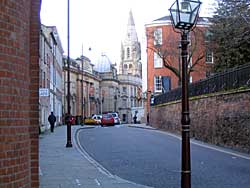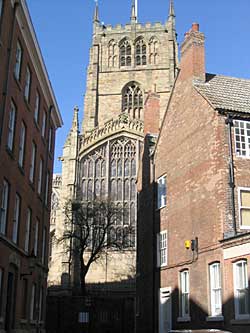< Previous | Contents | Next >
An itinerary of Nottingham
High Pavement and Commerce Square

Looking west along High Pavement: Shire Hall and the Unitarian Chapel are visible in the distance (A Nicholson, 2004).
HIGH Pavement has one of the most dignified histories of any street in Nottingham, for it was here during the XVII. and XVIII. centuries that some of the great Nottingham families had their residences. Its name is of interest and the word "Pavement" contains a pretty strong criticism of the condition of the roadways in ancient Nottingham. Weekday Cross was the old Market Place and as it would have to bear a tremendous amount of traffic in ancient days it is quite possible that it was paved with stones. This Pavement would be analogous to the area round about where Queen Victoria's statue now stands in the great Market Place and which is still referred to by some of our older friends as " The Stones." Gradually the stone pavement would be extended from Weekday Cross along the lines of High Pavement and of Middle Pavement and Low Pavement and so the name of High Pavement would arise.
Towards the close of the XVIII. century, that is to say about the year 1799, an attempt was made to alter the name of the street and a portion between Short Hill and St. Mary's Gate was called " St. Mary's Church Side." This was not a very successful venture and it seems to have been abandoned about 1815.
It is a narrow thoroughfare even nowadays, particularly the portion south of St. Mary's Church, and in ancient days it was very much narrower. There was a house at the south-east corner of St. Mary's Churchyard which belonged to the Duke of Kingston and which must have been terribly in the way of traffic coming up Hollowstone, at any rate he gave it to the town and it was pulled down in 1740. But it was not the only impediment to traffic, for about 1681 a row of houses was built along the south side of St. Mary's Churchyard which was not pulled down until 1792. These houses projected more than half-way across the modern roadway and the very narrow trackway which was left, albeit there were no footpaths, must have rendered the circulation of traffic extremely difficult, particularly when we remember that from the middle of the XVIII. century onward this was the main coach route into Nottingham.
Very little is known about these vanished houses. They were pulled down and a small slice was taken off the churchyard and the whole was thrown into the roadway, thus widening it to its present dimensions. The churchyard was held up by the great riveting wall which we now see, but in cutting off the slice of the burial ground many interments were disturbed, and the old histories and accounts of Nottingham tell very ghoulish stories of what was seen and done during the operations.
On the south side of the road are a series of rather curious buildings now used as warehouses, they have been knocked about and altered in all sorts of ways, but they still retain in their staircases, their roofs and various other details, memories of their past, and are of considerable interest to the antiquary. In particular, the doorway of No. 34, with its rustication and its mask marking the keystone is particularly nice. It is rather unfortunate that it is so heavily disfigured by signs and name-plates.

St Mary's church from Commerce Square (A Nicholson, 2004).
Commerce Square, which leads off High Pavement, is a particularly dull-looking place nowadays, but it had its moment in 1149. It was during the terrible times of the reign of King Stephen, the country was in a turmoil, families were divided against themselves and the country full of rapine and bloodshed. Nottingham Castle was held by the younger Peveril on behalf of King Stephen and was attacked by the Earl of Gloucester in command of a rabble acting on behalf of the Empress Matilda. He could not capture the Castle, but he succeeded in overrunning the town, and he subjected it to looting of a terrible description. His followers captured townsfolk and subjected them to all manner of indignities and tortures to make them disclose where their treasures were hidden. One such prisoner was Sweyn, who was by profession a moneyer, for in those days Nottingham possessed a mint which worked under royal license. In order to save his life, and the lives of those near and dear to him, Sweyn promised to show his tormentors where his treasure was hidden and so he led them to his house which was situated somewhere at the top of Long Stairs just about where Commerce Square now stands. Leading them through the ground floor storey he took them into a rock-hewn basement underneath his house which was pitch dark, and in this basement he declared they would find his stock of money. Eagerly they began to search and poke about in the darkness and while they were so engaged Sweyn managed to elude their vigilance and escape from their clutches.
He shut the door behind him and held his tormentors prisoners. In order to make assurance doubly sure, he set fire to his house and so consumed the robbers. But the remedy proved worse than the disease. The fire spread throughout the town of Nottingham, and so much damage was done that when Henry II. succeeded to the throne he was fain to assist the townsfolk in re-building their town and in constructing a great wall of defence round their homes in order to prevent a repetition of the disaster. Exhibited in the Castle Museum are a number of coins which show evidence of fire and whose provenance shows that they have been through this terrible fire of Nottingham.
A little bit farther westward stands a large house, next door to the Shire Hall, now occupied by certain departments of the County Council. In itself, beyond being a fine house of a hundred years or so of age, it is nothing particular, but it stands upon a site which was previously occupied by the House of the Trinity Guild. The Trinity Chapel in St. Mary's Church was situated in the North Transept, and very little is known about the activities of the Guild itself, but the house which stood on this site would probably be used as a residence for the priest or priests who were engaged by the Guild to conduct their services, and it would also form a sort of club-room for the member? of the Guild. At the Great Pillage in 1547, when nearly all the Guilds were suppressed and their enormous wealth, both of artistic treasures and material possessions were confiscated by the crown and to a large extent squandered, the possessions of this Guild were granted by the advisors of Edward VI. to the Nottingham Corporation for the upkeep of the Hethbeth Bridge, and are consequently part and parcel of the modern Bridge Estate.
